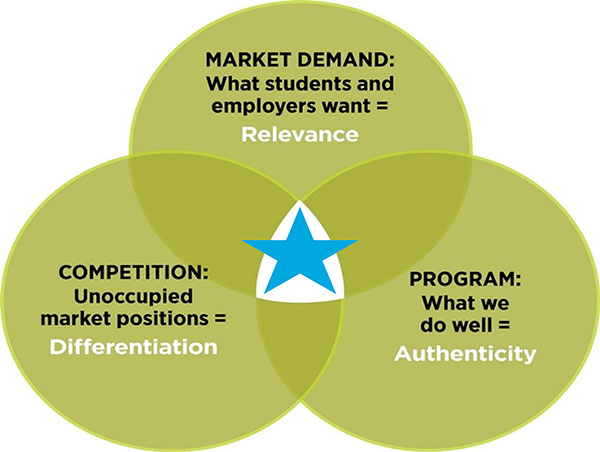enrollment
Aligning Your Academic Program Portfolio to Student and Labor Market Demand
This blog was co-written by Jessica Ickes, Vice President for Market and Research Services
Crucial questions to ask to harness market needs
Developing new academic programs and innovating within ones to meet evolving external market demand is critical but can be a daunting challenge for many colleges and universities. It may be overwhelming to consider where to begin with understanding what appeals to students and assessing the needs of the labor market. Depending upon your college or university sector, institutional culture, and established governance and planning processes, the intentional use of student and labor market demand data in your academic program planning process may vary, but ensuring a deep understanding of the market will assist your college or university in pursuing a rich, attractive, and desirable suite of academic programs that will position graduates for success.

The regular review and renewal of your academic program portfolio should be part of an established and ongoing process to ensure your college or university is serving learners and meeting expressed academic outcomes. Identifying and capturing the intersection of relevance, differentiation, and authenticity is the desired goal for academic programs planning at all degree levels. It is at this intersection that academic programs align to the interests of students, the needs of the labor market, and the core of your institutional identity. With knowledge of your competition, your position in the market, and commitment to your mission, your college or university will be well positioned to communicate unique value propositions to students, employers, and policymakers. The use of intentional, data informed processes that incorporate these perspectives and the willingness of your college or university to pursue programs at the intersection of this alignment is a strategic advantage.
Crucial questions to ask
1. How can we think strategically about academic program planning?
With changing demographics, shifting perceptions on the value of a degree, and increasing pressures on traditional financial models, colleges and universities are looking for ways to best serve students by aligning academic offerings with strategic market opportunities. Creating an academic program plan should be inclusive of voices and data from internal and external sources to gain insight into both student and labor market needs. Market gaps can be identified through study of economic and census data as a means of establishing an understanding of trends and enhanced through direct input from prospective students, parents, policy makers, and employers. A data-informed process aligned with your established shared governance structures can establish a creative and attractive program array that proactively addresses gaps in the market. Incorporating available market data early in strategic planning and curriculum development processes can improve efficiency in launching programs and allow for effective allocation of financial resources.
2. How do we assess if our academic programs are aligned with student demand?
When assessing current academic programs or creating new programs, it is important to understand the interests of those who will enroll and what they are seeking in the learning environment. This is not only limited to which programs students are interested in studying but considering their preferred modality. Examining student interest is important but also needs to be contextualized based on your institutional mission and degree level. Incorporating primary and secondary market data will enrich the academic program review process and build alignment in efforts to enroll and retain students. Primary market research can be gathered through surveys and focus groups. These processes require intentional design and allow for colleges and universities to interact directly with the communities they serve. Using secondary data from national and state labor data sources offers insights into trends and opportunities in your labor markets and employment needs. Combining primary and secondary sources allows your college or university to understand market direction and how your offerings are aligned with opportunities.
3. How do we know what our labor market needs?
Academic programs serve many purposes not exclusive to or limited by labor market needs. In today’s higher education environment, there is though increasing pressure from students, their families, and external bodies to understand the relationship between an academic program and a future occupation. Understanding labor market needs helps illustrate which jobs are in demand and provides a snapshot into where graduates can expect to find job opportunities. It can also identify key labor market needs and skills that can be infused and incorporated into existing academic programs. Additionally, engaging employers can open opportunities to partnerships and deepen your understanding of longer-term changes based on demographic shifts, policy initiatives, and macroeconomic factors that are impacting industry.
Understanding external factors such as demographics, student interests, and labor market needs can bring constituencies together in creating a strategic approach to offering programs that address market gaps and that are in formats that support learning objectives. Despite the challenges at hand for many colleges and universities, data-informed processes can help ensure programs are attractive to learners and demonstrate value. As you gather data and incorporate market trends into your planning processes, you will take important steps to remaining competitive in a changing environment. Creating a culture and process that systematically uses data and engages external communities will position your programs to succeed.
Ready to explore student and labor market demand to leverage strategic advantage?
Our market research consultants work with institutions throughout the country to better understand their markets meet and exceed strategic goals. Reach out and we can set up a time to discuss your research goals and how you can gather data that will help you enhance your academic program offerings and align them with your mission and strategic goals.
Ask for a free consultation with our research experts
RNL’s market research team helps campus leaders like you uncover the optimal approach to a variety of challenges: developing academic programs, identifying your ideal price point, assessing your competition, and much more. Find out what they can help you learn.
